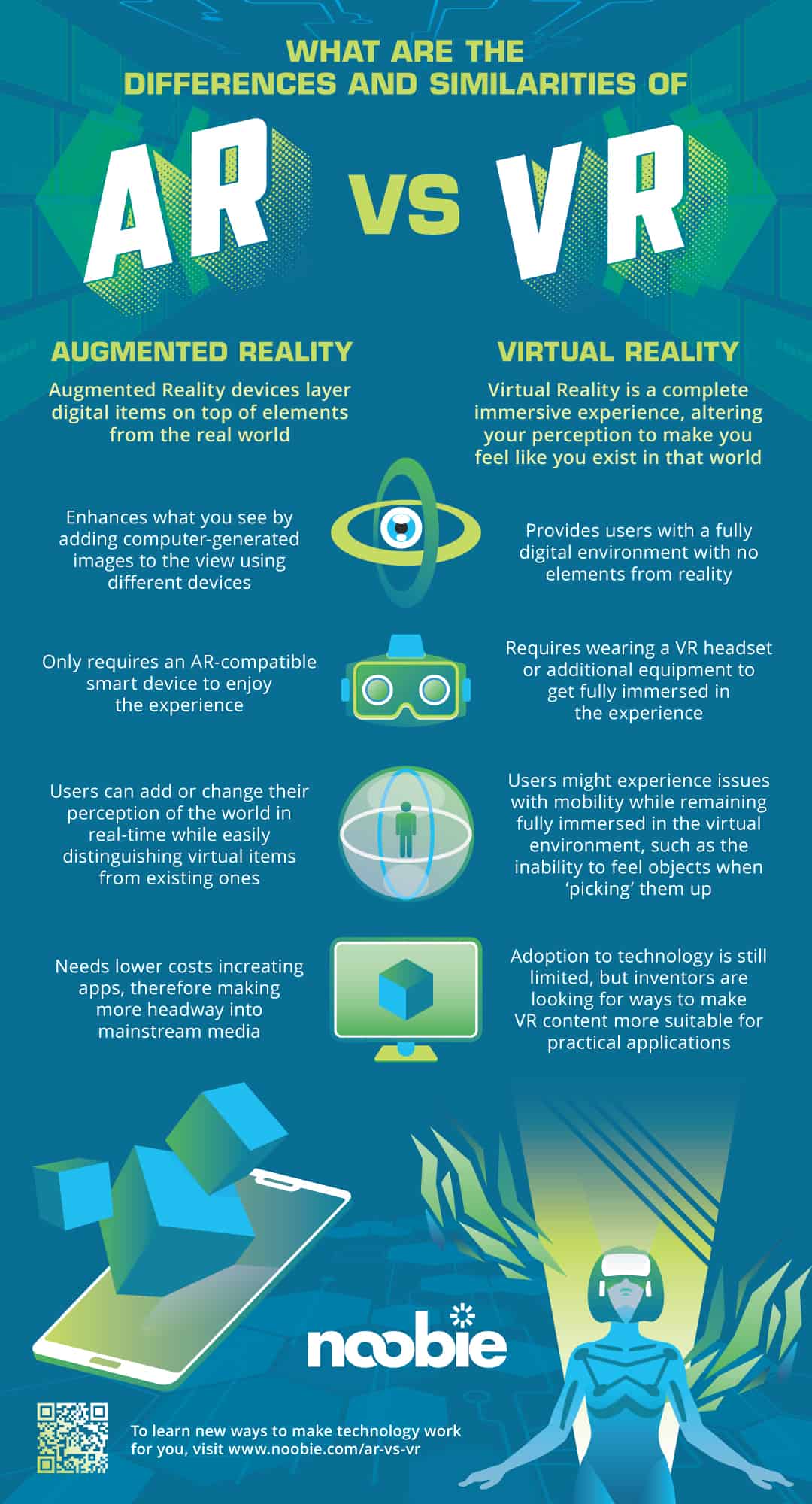What Is The Difference Between AR And VR?

In the world of technology, one of the common bones of contention is AR vs VR. What’s the difference between the two? Are there even some similarities? Read below to find out more!
In This Article:
- What Is Virtual Reality (VR)?
- What Is Augmented Reality (AR)?
- AR vs VR: How Do Virtual And Augmented Reality Differ?
- Where Are We with Mainstream Adoption of These Technologies?
- What Other Similar Technologies Exist?
AR vs VR | Spelling Out the Differences and Similarities
What Is Virtual Reality (VR)?
To help us answer the questions surrounding AR vs VR, let’s define both, starting with VR.
VR stands for virtual reality. This tech began in the late nineteenth century. The concept is simple: it replaces the user’s world with a digital one of their choosing.
In the VR technology, sensors within the equipment send signals to your brain, altering your perception of what you see and adding to the experience of existing in that world. You feel as though you’re moving around and interacting with the virtual objects inside the simulated environment.
Users wear a virtual reality headset or a head-mounted display made up of one or two computer screens to fully immerse themselves in the experience. Some types of setups are basic. They include using anything from complex VR goggles to simple cardboard holding a smartphone.
What Is Augmented Reality (AR)?
Devices using augmented reality layer digital items on top of elements from the real world. The AR technology allows you add to or change your perception of the world in real-time while easily distinguishing virtual items from existing ones.
You can use your tablet or smartphone to view these computer-generated creations. AR developers also make items such as glasses or other light headgear available to see them as well.
AR devices consume less power than VR equipment since you’re only adding computer elements instead of creating an entirely digital world.
The most popular use of AR to date was with the Pokémon Go game made available by Nintendo in 2016. With the mobile AR, users spend their time chasing digital Pokémon only viewable by downloading the app onto mobile devices.
AR vs VR: How Do Virtual And Augmented Reality Differ?

When it comes to AR vs VR, there are a lot of differences.
VR provides users with a fully digital environment with no elements from reality. AR, meanwhile, enhances what you see by adding computer-generated images to the view using different devices.
VR requires wearing a VR headset or other seemingly cumbersome gear to create a truly immersive experience. Some applications need additional equipment as well, such as a handheld controller to gain the full benefit of the experience.
VR devices must also mitigate issues with light bleeding and mobility while remaining fully immersed in a virtual environment. Picking up objects without being able to feel them often proves to be disorienting for users, for example.
AR, in contrast, only requires you to have some sort of smart device to enjoy the experience. The Snapchat app is a type of AR that places digital images over your own face to share with other people.
Other apps such as Layar pull up pieces of information about places you’re currently visiting or help you find ATMs, restaurants, or other points of interest.
Where Are We with Mainstream Adoption of These Technologies?
More large companies are investing in making their technology compatible with VR experiences. YouTube, for example, provides a way for users to connect their gear and see videos from a 360-degree perspective.
The Oculus Rift and Google Cardboard allow you to visit places without actually setting foot in them. Imagine climbing Mount Everest or viewing an erupting volcano in Hawaii up close.
AR appears to be making more headway into the mainstream due to the lower costs of creating the apps. Google now provides updates to its previously abandoned Google Glass technology, which lets users put on glasses to pick up on digital enhancements instead of using a handheld device.
Adoption of VR at the moment is still limited for the most part to enthusiasts of the technology. Inventors continue to look for ways to make VR content more suitable for a lot of practical applications and make it more mainstream.
The adoption of 5G connectivity should help improve the outlook for both VR and AR. It reduces issues with lagging images often plaguing these technologies. It also does a lot to enhance the handling of high user traffic and network efficiency.
Large corporations and independent developers continue making investments to make these techs commercial. The market is projected to be worth nearly $27 billion dollars by the year 2022. The pace of advancing technology and improved network speeds should help push these apps even more into the lives of regular people.
What Other Similar Technologies Exist?
The exploration of AR vs VR gave birth to other complementing technologies. Mixed reality, such as that of Windows, shows the most promise of all of them.
You’re allowed to up to one-third of your real environment taken over by digital imagery and actually interact with them the way you would with VR. That pushes you further into an immersive environment than standard AR without taking you into a fully digital world the way VR does.
Download this infographic now and reference it later.

Learn in this video how AR and VR differ:
With AR vs VR, there are many differences that make them unique from each other, but they are also similar in the way they let you see the world. With them, virtual experiences can become more engaging and fun.
What do you think about the AR vs VR comparison? Let us know in the comments section below.
Up Next: How Technology Benefits Education | 7 Ways Tech is Taking Over








